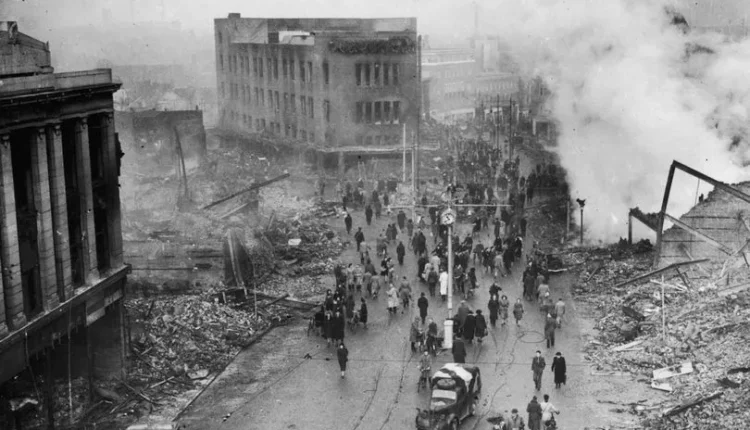Devastating impact of Luftwaffe attack on Coventry church – and how raiders drank champagne.
Today, 29 October, celebrates 85 years since the Foleshill gas plant raid that devastated the roof of St Laurence’s Church. A former clergyman and Coventry author has written an intriguing tale of a bombing raid on Foleshill Church.
Today marks 85 years since the raid on the Foleshill gasworks on October 29, 1940. Some of the incendiary bombs missed their intended target and landed on the roof of St Laurence’s Church on Old Church Road.
The raid came just weeks before the Coventry Blitz on November 14, which ravaged the city, killing hundreds and damaging thousands of homes.
Tony Upton served as vicar at St Laurence’s from 1983 to 1991 and has conducted substantial research on the church’s history. For his book Burnt Roof:
The Bombing of St Laurence’s Church, Foleshill, Coventry, he even spoke with Hermann Schmidt, who directed the air raid on Foleshill Gasworks on October 29, 1940, and the city sixteen days later.
Mr Upton described how Hermann Schmidt and the other raiders drank champagne following the October 29 raid. Interesting history of the church.
St Laurence’s was the first church in the Coventry diocese to be damaged by enemy action, and until it was rebuilt, services were held in a wooden hut.
Mr Upton stated that the church has a rich history, with connections to Lady Godiva and author George Eliot. “It is the historic mother church of Foleshill (Lady Godiva’s manor before the Norman Conquest).
1066),” he stated. “It is also the mother church of St Paul’s in Foleshill, which was consecrated in 1842. George Eliot, who lived just around the corner at Bird Grove House in Foleshill, attended the service.
As the bombs impacted on St Laurence’s roof, another hit the barred entrance to the air raid shelter outside the church.
Gordon Edwards, a 17-year-old ARP messenger boy, broke a window to enter the church and opened the latch, allowing firefighters to extinguish the fire.
Gordon was tragically killed on duty during the Coventry Blitz only weeks later, on November 14.
On October 29, 1990, fifty years after the youngster’s courageous efforts, a service was held at the church, and a memorial stone was set to honour his bravery. The roof of St. Laurence was left exposed to the sky.
As Hermann Schmidt and his fellow raiders drank champagne, the vicar of St Laurence, who had received the Military Cross in World War I, was still cleaning up the aftermath of an incendiary bomb that had exploded through the Vicarage’s roof. The roof of St. Laurence was left exposed to the sky.
As Hermann Schmidt and his fellow raiders drank champagne, the vicar of St Laurence, who had received the Military Cross in World War I, was still cleaning up the aftermath of an incendiary bomb that had exploded through the Vicarage’s roof.
Who was Hermann Schmidt?
Mr. Upton described Hermann Schmidt, who commanded bombing raids on Coventry, as a “accomplished commanding officer who had earned the Iron Cross by the end of May 1940.”
He was born in 1910 and worked three civilian jobs until joining the Luftwaffe in 1935. In 1939, he was assigned to a unique squad entrusted with establishing a precise method for guiding bombers to their objectives.
They later became known as pathfinders, and Schmidt was one of the most accomplished and well-regarded among them.
After operating in Norway, the unit relocated to Vannes, near the coast of Brittany, where they conducted raids on Coventry and other parts of Britain.
Following Mr. Upton’s conversation with Hermann Schmidt, Mr. Schmidt lent him his personal logbook, which detailed his experiences. As he approached Coventry on October 29, he noticed a modern route south of the city (the Coventry By-pass).
Schmidt had assessed the anti-aircraft resistance as ‘poor’ during his first mission over Coventry on October 12th, but on this, his fifth bombing raid over Coventry, he was met with a ‘noticeably stronger reception.
His exact path through Coventry is unclear, but the bombers released their incendiaries.
‘in a strip of gleaming lights’.
By the end of the war, Hermann Schmidt was among the Luftwaffe’s most decorated members. He went on to serve in the German Army, retiring in 1968 as a Colonel. He died in January 1992.
Aftermath
The church roof at St Laurence was not fully renovated until the 1980s, when parishioners raised thousands of pounds. Mr Upton said that as contractors removed the slates, many beams and rafters were discovered to be severely burned.
Some of the displaced rafters were converted into little crosses and sold to earn funds for the restoration, but one remained in the roof and was engraved with the words ‘burnt roof 1940’.
Read more on Straightwinfortoday.com


Comments are closed, but trackbacks and pingbacks are open.